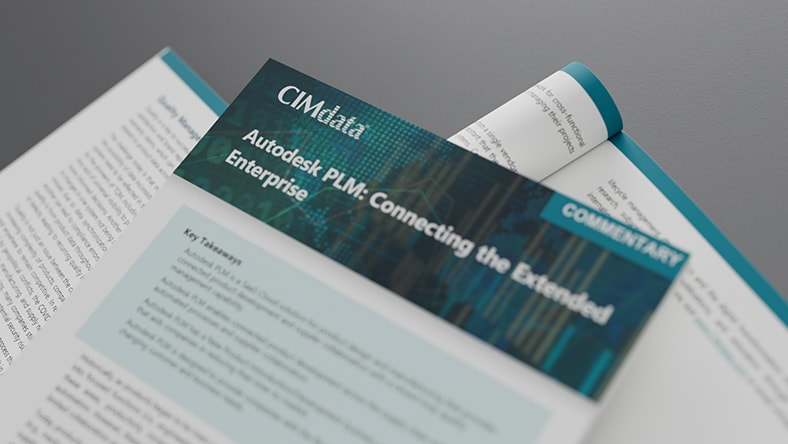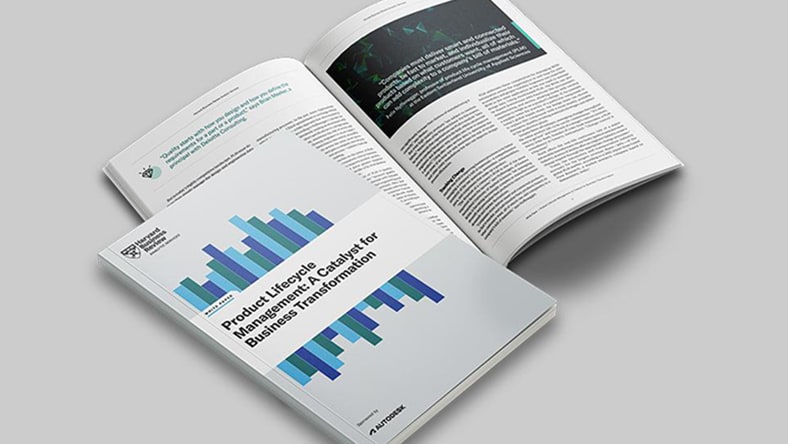& Construction

Integrated BIM tools, including Revit, AutoCAD, and Civil 3D
& Manufacturing

Professional CAD/CAM tools built on Inventor and AutoCAD
From design reviews to field quality issues, any number of reasons can start the gears of engineering change turning. But there’s a way to manage these changes and avoid chaos. In our free webinar, Controlling Change Management, we’ll show you how companies like yours can benefit from a product lifecycle management (PLM) approach to engineering change orders (ECO).
Enable stakeholders to submit engineering change requests (ECR) in the cloud, for greater efficiency and better visibility into the overall change process.
Track all engineering change orders (ECO) in a centralized location and ensure everyone has the latest information for reviews, approvals, and audits.
Notify each stakeholder of status and action items automatically with engineering change notifications (ECN) that provide real-time insight into change status.
Provide team members with the action, review, or approval tasks they need to close ECOs more quickly with built-in dependencies and automated scheduling.
See how changes will affect different parts of your business, including products, processes, and resources to fully understand their implications.
Configure formal and fast-track workflow processes that meet the needs of your organization—defining, reviewing, approving, and implementing engineering changes with more collaboration.
View and understand how your entire change management process works—from monitoring overall performance to identifying specific areas for improvement.
Integrate change management into your quality process, capturing complete product specifications and providing access to each stakeholder in real time.
Maintain all ECRs and ECOs in a centralized system for a complete historical picture—who was involved and when, which items were modified, and much more.
COMMENTARY
See what experts CIMdata say about managing change in the connected enterprise with Autodesk PLM.
Report
Explore how PLM addresses critical business challenges—like engineering change management.
E-book
Improve quality, reduce costs, and accelerate time to market with a connected PDM-PLM process.
Increase product development agility and reduce time spent on low- and no-value tasks by integrating PDM into your existing CAD workflows.
Give your teams the real-time data access they need over the entire product lifecycle with a centralized, cross-departmental bill of materials that keeps data integrity.
Magnify the impact of your quality processes with cloud-based tools that help you improve product designs, identify supplier problems, and accelerate time to market.
Bring more agility to your new product introductions (NPI) with configurable processes that shorten the time from new product concept to production.
Anticipate and react to supply chain issues more rapidly by providing 24/7 access to quoting, procurement, and supplier management tools.
Integrate powerful PLM processes into your team’s existing CAD workflows—and keep everyone on the same page and collaborating more effectively.
Connecting your engineering change management processes to Autodesk PLM is easier than you might think. Talk to Sales about how automated, configurable processes can help you improve quality and reduce wasted effort.
Engineering Change Management (ECM) is a systematic and controlled approach that manages alterations or modifications in a product’s design, process, or related documentation throughout its lifecycle. It ensures that any changes made are documented, reviewed, and approved before implementation, maintaining consistency and traceability. ECM includes processes such as Engineering Change Orders (ECOs) or Engineering Change Notices (ECNs). These changes can result from various factors, including design enhancements, manufacturing improvements, regulatory requirements, or customer feedback. ECM plays a crucial role in preserving product integrity, reducing errors, and enhancing overall product quality.
Change management in a PLM system like Autodesk Fusion Manage is a structured process that oversees and controls modifications in a product's design, manufacturing process, or associated documentation throughout its lifecycle. It offers tools for creating and managing Engineering Change Requests (ECRs) and Engineering Change Orders (ECOs), ensuring a seamless transition from proposed changes to approved alterations. It allows for collaboration across different teams, providing real-time visibility into the change process. It also maintains a complete history of changes for full traceability. By automating workflows and facilitating efficient change implementation, PLM reduces errors, enhances product quality, and shortens time-to-market.
In the manufacturing sector, ECR stands for Engineering Change Request. It outlines a proposed alteration to a product's design or manufacturing process. An ECR initiates the change process by identifying an issue or potential improvement, providing a rationale for the change, and suggesting possible solutions. It is typically written by any stakeholder involved in the product's lifecycle, such as an engineer, a quality inspector, or a customer. Once submitted, the ECR is reviewed and, if approved, leads to an Engineering Change Order (ECO), which details the specific changes to be executed. Thus, ECRs are vital in maintaining product quality and efficiency.
Product lifecycle management (PLM) streamlines the Engineering Change Request (ECR) process by providing a centralized system for documenting, tracking, and managing change requests. It enables efficient capture of ECRs, detailing proposed changes, reasons, and potential impacts. PLM ensures all stakeholders have real-time access to the ECR data, promoting collaborative review and decision-making. It automates workflows, reducing manual tasks, and speeding up the approval process. It also keeps a complete audit trail of changes, ensuring traceability and compliance. By integrating with other business systems like ERP or CAD, PLM provides a holistic view of the change impact, allowing informed decisions, which helps improve product quality and reduce time-to-market.
Product lifecycle management (PLM) systems handle documentation and approval during the change management process in a comprehensive and structured manner. PLM tools ensure that all proposed changes, from Engineering Change Requests (ECRs) to Engineering Change Orders (ECOs), are thoroughly documented and stored in a centralized database. This allows for easy retrieval, review, and tracking. The system streamlines the approval process by automating notifications and routing approvals to the appropriate stakeholders, reducing delays and enhancing efficiency. It maintains a complete audit trail of the change process, including who approved what and when, ensuring accountability, transparency, and compliance with industry standards and regulations.
Yes, you can track the status of a change order in a Product Lifecycle Management (PLM) system. PLM tools are designed to provide real-time visibility into the change management process. They allow users to monitor the progress of Engineering Change Orders (ECOs) from initiation to closure. This includes tracking the approval process, implementation stages, and verification of the changes. Notifications or alerts can be set up to inform stakeholders of any updates or delays. This transparency helps in managing expectations, improving collaboration, and ensuring timely completion of changes. By tracking the status of change orders, PLM systems enhance efficiency and accountability in the change management process.
Product lifecycle management (PLM) systems facilitate collaboration during the change management process by providing a centralized system where all stakeholders can access and share information in real-time. They allow for simultaneous reviewing and editing of documents like Engineering Change Requests (ECRs) or Engineering Change Orders (ECOs), promoting cross-functional collaboration. Automated workflows can route changes to appropriate team members for review or approval, notifying them of their tasks. Additionally, PLM systems support communication features like comments or discussion threads, fostering dialogue among teams. By making the change process transparent and accessible to all involved parties, PLM systems ensure that every voice is heard, enhancing decision-making and implementation efficiency.
Yes, a PLM system like Autodesk Fusion Manage offers the capability to customize the change management workflow according to your specific business needs. You can define the steps involved in the change process, from the creation of Engineering Change Requests (ECRs) to the approval and implementation of Engineering Change Orders (ECOs). The system allows you to set rules for routing approvals, notifications, and tasks to appropriate stakeholders based on your organizational structure and procedures. This flexibility ensures that your change management process aligns with your unique operational requirements, enhancing efficiency, reducing errors, and improving overall product quality.
Effective change management in manufacturing significantly contributes to cost reduction by increasing efficiency and reducing errors. A structured change process ensures that all modifications, from design alterations to process improvements, are thoroughly reviewed and approved before implementation. This minimizes the risk of costly errors or rework. By maintaining a clear record of changes, it aids in avoiding duplication of effort and conserves resources. Automated change management workflows in systems like PLM reduce manual tasks and speed up the change process, saving time and labor costs. Effective change management can help organizations adhere to regulatory standards, avoiding potential fines or recalls. Well-managed change is a significant cost-saving strategy in manufacturing.
Change management in manufacturing plays a crucial role in enhancing compliance with industry standards and regulations. A robust change management process ensures all modifications are reviewed and approved in alignment with quality standards and regulatory requirements. It maintains a complete audit trail of changes, from initiation to implementation, providing evidence of compliance during audits. The system's documentation capabilities aid in maintaining necessary documentation for regulatory bodies. Furthermore, it can be configured to include compliance checks at various stages of the change process. By ensuring changes don't deviate from regulatory norms and providing transparency into the change process, change management aids in maintaining regulatory compliance in manufacturing.



